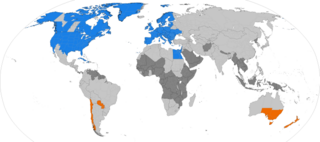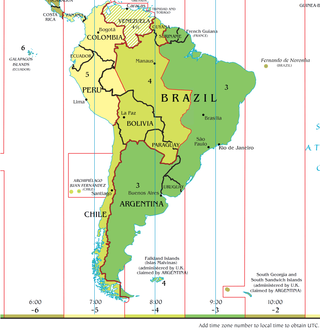Related Research Articles

A time zone is an area which observes a uniform standard time for legal, commercial and social purposes. Time zones tend to follow the boundaries between countries and their subdivisions instead of strictly following longitude, because it is convenient for areas in frequent communication to keep the same time.

Daylight saving time (DST), also referred to as daylight saving(s), daylight savings time, daylight time (United States and Canada), or summer time (United Kingdom, European Union, and others), is the practice of advancing clocks to make better use of the longer daylight available during summer so that darkness falls at a later clock time. The typical implementation of DST is to set clocks forward by one hour in spring or late winter, and to set clocks back by one hour to standard time in the autumn (or fall in North American English, hence the mnemonic: "spring forward and fall back").

Central European Time (CET) is a standard time of Central, and parts of Western Europe, which is one hour ahead of Coordinated Universal Time (UTC). The time offset from UTC can be written as UTC+01:00. It is used in most parts of Europe and in a few North African countries. CET is also known as Middle European Time and by colloquial names such as Amsterdam Time, Berlin Time, Brussels Time, Budapest Time, Madrid Time, Paris Time, Rome Time, Prague time, Warsaw Time or Romance Standard Time (RST).

Summer time in Europe is the variation of standard clock time that is applied in most European countries in the period between spring and autumn, during which clocks are advanced by one hour from the time observed in the rest of the year, with a view to making the most efficient use of seasonal daylight. It corresponds to the notion and practice of daylight saving time (DST) to be found in some other parts of the world.

Australia uses three main time zones: Australian Eastern Standard Time, Australian Central Standard Time and Australian Western Standard Time.

There are 11 time zones in Russia, which currently observe times ranging from UTC+02:00 to UTC+12:00. Daylight saving time (DST) has not been used in Russia since 26 October 2014. From 27 March 2011 to 26 October 2014, permanent DST was used.

Argentina is located at a longitude that would naturally put it in the UTC−04:00 or UTC−05:00 time zone; however, it actually uses the UTC−03:00 time zone. Argentina determines whether to change clocks in observation of daylight saving time on a year-by-year basis, and individual provinces may opt out of the federal decision. At present, Argentina does not change clocks.

The time zone in Germany is Central European Time and Central European Summer Time. Daylight saving time is observed from the last Sunday in March to the last Sunday in October. The doubled hour during the switch back to standard time is named 2A and 2B.

Europe spans seven primary time zones, excluding summer time offsets. Most European countries use summer time and harmonise their summer time adjustments; see Summer time in Europe for details.

Daylight saving time (DST), also known as summer time, is the practice of advancing clocks during part of the year, typically by one hour around spring and summer, so that daylight ends at a later time of the day. As of 2024, DST is observed in most of Europe, most of North America and parts of Africa and Asia around the Northern Hemisphere summer, and in parts of South America and Oceania around the Southern Hemisphere summer. It was also formerly observed in other areas.
Bosnia and Herzegovina uses a single time zone, denoted as Central European Time. It also observes summer time, shifting to Central European Summer Time.
Time in the Kingdom of the Netherlands is denoted by Central European Time during the winter as standard time in the Netherlands, which is one hour ahead of coordinated universal time (UTC+01:00), and Central European Summer Time (CEST) during the summer as daylight saving time, which is two hours ahead of coordinated universal time (UTC+02:00). The Caribbean Netherlands – which consist of the islands of Bonaire, Sint Eustatius and Saba – all observe Atlantic Standard Time (AST) year-round, which is four hours behind coordinated universal time (UTC−04:00).
In Sweden, the standard time is Central European Time. Daylight saving time is observed from the last Sunday in March to the last Sunday in October. Sweden adopted CET in 1900.
In Andorra, the standard time is Central European Time. Daylight saving time is observed from the last Sunday in March to the last Sunday in October. Andorra adopted CET after WWII.

Time in Poland is given by Central European Time. Daylight saving time, which moves an hour ahead, is observed from the last Sunday in March to the last Sunday in October. This is shared with several other EU member states.
In Slovenia, the standard time is Central European Time. Daylight saving time is observed from the last Sunday in March to the last Sunday in October. This is shared with several other EU member states.
In San Marino, the standard time is Central European Time. Daylight saving time is observed from the last Sunday in March to the last Sunday in October. This is shared with several other EU member states.

Svalbard, an archipelago in the Arctic Ocean belonging to the Kingdom of Norway, uses Central European Time (CET) during the winter as standard time, which is one hour ahead of Coordinated Universal Time (UTC+01:00), and Central European Summer Time (CEST) during the summer as daylight saving time, which is two hours ahead of Coordinated Universal Time (UTC+02:00). This is shared with the rest of Norway, as is Svalbard's use of daylight saving time, which the territory observes annually by advancing the clock forward on the last Sunday in March and back again on the last Sunday in October. However, as Svalbard experiences midnight sun during the summer due to being located north of the Arctic Circle, it gives daylight saving time no utility, and is only observed in order to make communicating with Norway Proper more convenient. At the 74th parallel north, the midnight sun lasts 99 days and polar night 84 days, while the respective figures at the 81st parallel north are 141 and 128 days.
In Liechtenstein, the standard time is Central European Time. Daylight saving time is observed from the last Sunday in March to the last Sunday in October. Liechtenstein adopted CET in 1894.

Time in Libya is given by a single time zone, officially denoted as Eastern European Time. The zone is also known as Central Africa Time (CAT). Libya has observed EET since 5 November 2012, after it was announced in 2013 that Libya would be on permanent daylight saving time. Libya previously observed several different time zones as standard time and daylight saving time. For residents of western Libya, including Tripoli, solar time is usually one hour behind standard time.
References
- ↑ Europe. WorldTimeZone.com.
- ↑ Messerli, Jakob (1995). Gleichmässig – pünktlich – schnell: Zeiteinteilung und Zeitgebrauch in der Schweiz im 19. Jahrhundert (in German). Zürich. p. 72. ISBN 3-905311-68-2. OCLC 717570797.
{{cite book}}: CS1 maint: location missing publisher (link) - ↑ Stuewer, Roger H. (2009). The Physical Tourist: A Science Guide for the Traveler. Springer London. p. 128. ISBN 9783764389338 . Retrieved 28 March 2022.
- ↑ "Verordnung des Bundesamtes für Landestopografie über Geoinformation" [Ordinance of the Federal Office of Topography on Geoinformation] (in German). Fedlex: The publication platform for federal law. 26 May 2008. Retrieved 28 March 2022.
- ↑ Black, Charles Bertram (1873). "Guide to Switzerland and the Italian Lakes". Sampson Low, Marston & Company. p. 21. Retrieved 28 March 2022.
- ↑ "Circulaire du conseil fédéral" (in French). Swiss Federal Council. 13 December 1893. Retrieved 28 March 2022– via Swiss Federal Archives.
- ↑ "Protokol Sitzung des schweizerischen Bundesrates" [Minutes of the session of the Swiss Federal Council](PDF) (in German). Swiss Federal Council. 7 November 1941. p. 24. Retrieved 28 March 2022– via Swiss Federal Archives.
- ↑ {{cite web|url=https://www.swissinfo.ch/eng/society/daylight-saving-time-when-switzerland-was-a-lost-island-in-europe/48924796
- ↑ Eggert, Paul (2013-03-02). "tzcode2013a and tzdata2013a available". ICANN.
- ↑ Olson, Arthur David (2012-03-03). "New zone for DE, split from Europe/Berlin". gmane.comp.time.tz.
Notes
- ↑ Measured at 46°57′08″N7°26′22″E / 46.95222°N 7.43944°E . [4]